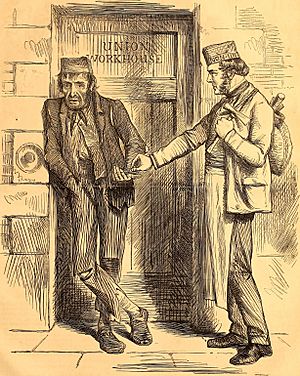Sarcasm facts for kids

Sarcasm is a type of speech or a comment that can be hard to understand. It's when someone says something that means the opposite of what they actually intend. People might use sarcasm to be funny, or sometimes, to be unkind.
The main idea behind sarcasm is to sound friendly while actually being a bit mean or critical. The word "sarcasm" comes from the Greek word sarcasmus. But usually, there are clues that help you understand if someone is being sarcastic. For example, if a parent says "Oh, that's clever!" when their child makes a mistake, their tone of voice often shows love. This is very different from someone unfriendly saying "Oh, here comes Mr. Clever-clogs!" So, people learn to figure out the real message.
It's much harder to tell if someone is being sarcastic when they speak in a flat, neutral voice, which is sometimes called "deadpan" or "dry humor." Some experts believe that this kind of sarcasm is often meant to be unkind.
It's also important to remember that sarcasm doesn't always work well in writing or when translated into another language.
Contents
How Your Voice Shows Sarcasm
In English, people often show sarcasm by speaking more slowly and with a lower voice. In Dutch, a lower voice is also used, sometimes so low it sounds like a mumble. But other studies show that people use many different ways to signal sarcasm with their voice.
For example, in Cantonese, people might raise the pitch of their voice to show sarcasm. In Amharic, a rising tone at the end of a sentence can mean sarcasm.
Punctuation for Sarcasm
In English writing, there isn't one special mark to show sarcasm or irony. However, some people have suggested different punctuation marks over time. One old idea was the "percontation point" or "irony mark," which looked like a backwards question mark (⸮). These marks were mostly for irony, which is similar to sarcasm.
More recently, some have suggested marks like the "snark mark" or using a tilde (~) to specifically show sarcasm. Sometimes, people also use an exclamation point or question mark in brackets (!?) or scare quotes (like "amazing") to show that they don't really mean what they're saying.
In some Ethiopic languages, there is a special sarcasm mark called temherte slaq. It looks like an upside-down exclamation point (¡) and is placed at the end of a sentence.
Sarcasm vs. Irony: What's the Difference?
Sarcasm is usually harsh teasing or making fun of someone. It often goes hand-in-hand with verbal irony, which means saying the opposite of what you mean. While they are often used together, sarcasm doesn't always have to be ironic, and you can use one without the other.
Here are examples where sarcasm and irony are used together:
- "My, you're early!" (Said to someone who arrives very late).
- "What a fine artist you've become!" (Said when someone has done something badly).
Here is an example of irony without sarcasm:
- After a popular teacher says sorry for answering his phone during class: "I don't know if we can forgive you!" (This is ironic because the students clearly forgive him, but it's not meant to be harsh or sarcastic).
Images for kids
-
A sarcastic comment below a memorial plaque for Alois Alzheimer. He was the first person to describe Alzheimer's disease. The German words mean "Alois, we will never forget you!" This plays on the idea that the disease makes people forget, which is ironic for a memorial.
See also
 In Spanish: Sarcasmo para niños
In Spanish: Sarcasmo para niños


